English Electric B(I) Mk.12 Canberra
In 1963 the South African Air Force (SAAF) procured six B(I) Mk.12 Canberra interdictors and three T. Mk.4's from Britain. Initially the Canberra was seen as an interim measure until the arrival of Hawker-Siddeley Buccaneers in 1965. The SAAF used the B(I) Mk.12 as bombers and interdictors over a 27 year period.
With simmering tension in Portuguese controlled Angola threatening to spill over into the South African controlled territory of South West Africa (Namibia), the SAAF's 12 Squadron started to fly recon missions over northern SWA and southern Angola. During the late 1960's and early 1970's South Africa got sucked into its own Vietnam war. Believing that the domino theory also applied to Africa, the South African apartheid government decided to intervene in the Angolan civil war that raged between opposing political factions: MPLA (Communist backed faction), UNITA and the FNLA (Supported by the USA and South Africa). UNITA and the FNLA controlled areas in the south and north of Angola whilst the MPLA, with the aid of Cuban and Russian weapons and advisors, waged open war against UNITA and the FNLA. The South African government believed that SWAPO (South West African People's Organization) got weapons and training in MPLA controlled Angola and then crossed into SWA to wage a 'terrorist' campaign against the white farmers in SWA as part of a campaign to liberate SWA from South African control.
With the encouragement of Western powers looking to restore the balance of power in the region, South Africa launched a large scale incursion into Angola (Operation Savannah) in support of anti-communist forces in 1975. This operation served as a baptism of fire for the SAAF's Canberra force. Three 12 Squadron Canberra's flew bombing and recon sorties. The SAAF Canberra force was again called upon during Operation Reindeer to attack large enemy camps known as Alpha, Bravo and Charlie. In August 1978 SAAF Canberra bombers attacked targets in Zambia to stop insurgents moving from Zambia into the Caprivi strip in northern SWA.
In March 1979 the SAAF deployed the Canberras to SWA for a nine-day intensive bombing campaign against enemy insurgent bases in southern Angola and south-west Zambia. On 14 March 1979, four Canberras were detailed to attack a target near Cahama in southern Angola. Over the target, the Canberra (serial number 452) piloted by Lt. D. Marais and 2/Lt. O.J. Doyle was seen to fall away from the formation, climb steeply, then dive into the ground where it exploded. The loss of Canberra 452 has been officially ascribed to the pilot being fatally struck by Russian supplied anti-aircraft artillery over the target.
The Canberras finest hour in Angola was during the battle of Mavinga in mid-1987. A combined force of Cuban and MPLA troops attacked a combined South African and UNITA force along the Lomba River and around Mavinga. Facing an overwhelming force supported by Mi-8, Mi-17, Mi-25 and Mi-35 helicopters as well as an umbrella force of Mig 21, Mig 23 and Sukhoi Su-22's the SAAF sent its Canberras to bomb the enemy whilst SAAF Mirage F-1CZ's engaged the fighters. During the ensuing melee Cmdt. J Rankin, flying a Mirage F-1CZ, downed his second Mig 21 of the Bush War. The battle of Mavinga and the Lomba river saw the combined enemy force annihilated. After the fall of communism in 1989, the South African government ended its involvement in Angola and granted SWA independence. The ageing Canberra force was subsequently retired and eventually sold to Peru.
This is the superb 1/48 scale Airfix Canberra. The kit contains SAAF markings. However, it is the markings for a SAAF Canberra in NMF circa 1963. I chose to build Canberra 452 that was lost over Cahama in southern Angola. Custom made decals from MAV decals were used. The aircraft was decked out in Humbrol PRU blue. Weathering was kept to a minimum. The weapons load for this particular mission called for GP low drag bombs. The bombs were courtesy of a Hasegawa weapon set. The Canberras in SAAF service carried a wide array of bombs and rocket pods during the war in Angola. I scratchbuilt the towel rail antenna and sensors and antennae under the rear fuselage. The pilots ejection seat was also detailed with Evergreen styrene and copper wire. The undercarriage was also detailed with copper wire. This is a BIG model and VERY tail heavy. The area behind the cockpit as well as the front of the engine nacelles were packed with lead weights. The main undercarriage was strengthened by drilling a hole vertically into the landing gear and inserting a thin steel rod.
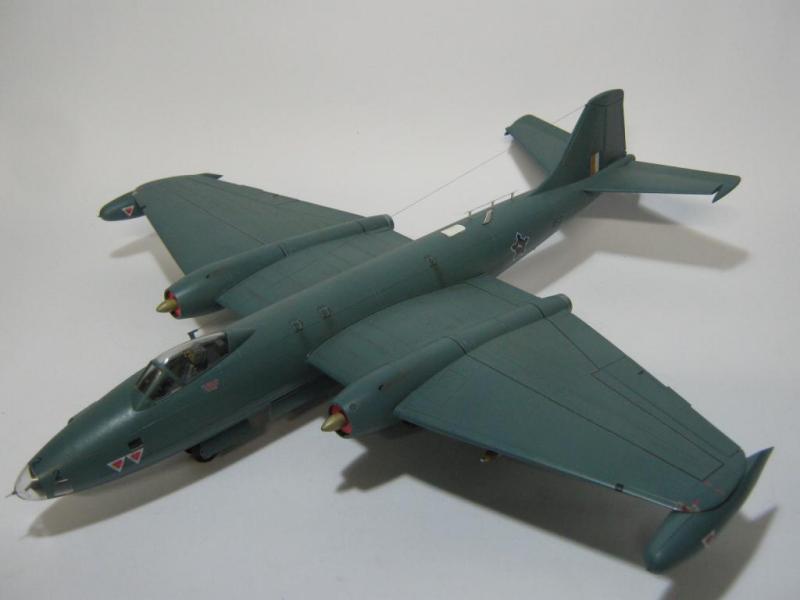

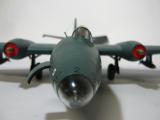
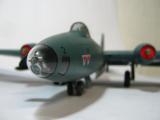
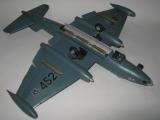
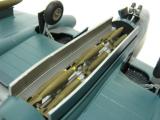
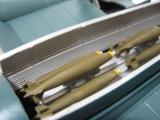
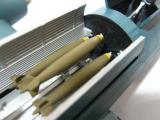
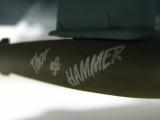
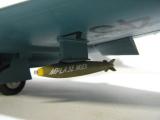

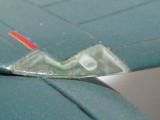
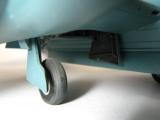
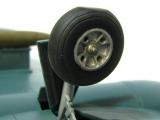

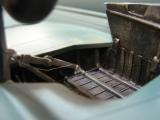
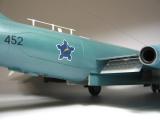
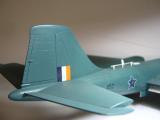
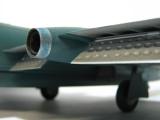
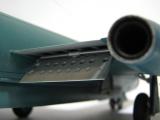
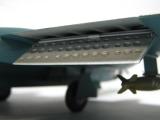
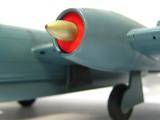
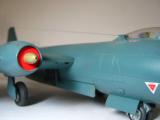
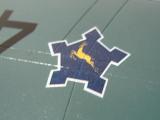
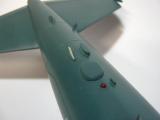
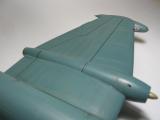

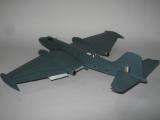
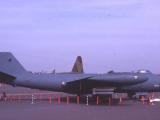

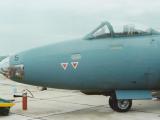
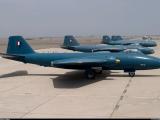
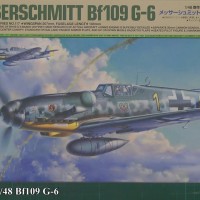
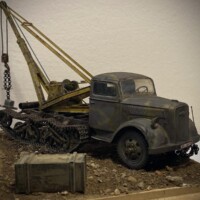
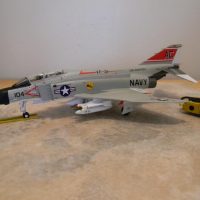

Nicely finished and photographed, Morne...as I recall, this was the only Airfix kit I'd done previously - it was then the only game in town (I think). You can see it here: http://imodeler.com/2012/11/airfix-148-b-57-intruder/
I've discovered I DID indeed build another Airfix kit...the EE Lightning in 48th scale. In fact, Martin pointed out the fact that there wasn't another offering of it in the scale.
http://imodeler.com/2012/11/48th-english-electric-lightning/
Very nice builds too, Craig ! The NMF looks great, time to surf deeper in your huge blog !
Thanks Craig. Airfix released two different versions of the Canberra. The bomber and recon varriants. This was followed by their Martin B-57 with parts to build a B-57 C / G. With some TLC they build into very nice models. Albeit they take up a lot of display space.
Eine perfekte Geschichtsstunde Morne ! With a very nice and flawless Canberra and great pictures, an outstanding presentation, love it !
I did know nearly nothing about this conflict, a lot to learn. looking into history of mankind, since...Sumer, was there any period without wars? I guess not.
Great build, my friend and a good time for Canberras here
Vielen Dank mein Freund! The war in Angola was one of those conflicts that formed part of the greater Cold War conflict between East and West. The fact that Cuba and the USSR got involved frightened the USA since a likely communist advance to the south would threaten South Africa's supply of gold, diamonds and importantly uranium to the West. The threat was deemed as genuine by the CIA and the USA supplied weapons, notably Stinger missiles to Jonas Savimbi of UNITA and 'moderate' support to the Apartheid government in South Africa. During the 1980's British PM Thatcher and US President Reagan backed SA's involvement in Angola. During this period the SAAF was hampered by the international arms embargo imposed against South Africa by the European powers and the UN. Subsequently Israel supplied technology clandestinely to upgrade South Africa's war machine. The SAAF Mirage III fleet were turned into the superb Atlas Cheetah C's using Israeli Kifr technology. Most of the assistance provided by Israel during the Apartheid era is still shrouded in secrecy!
Ein Stellvertreterkrieg, Good morning an highly informative article !
These cold war "side games" were bloody and brutal.
The Canberra family from Airfix is currently not in production, i hope i they will come back, its a very important type, here is a link about:
http://www.bywat.co.uk/cantitle.html
I was unaware that they are out of production. They are very basic kits but build into very nice renditions of the Canberra family including the Martin B-57. Thanks for the web link!
Nice done Morne. I love the color and a SAAF aircraft is so rare and original. Good job and nice choice
Emmanuel
Thanks Emmanuel. The SAAF operated nearly every Mirage III type as well as the beautiful Mirage F-1CZ and F-1AZ. These have all been retired in favour of the SAAB Gripen. The SAAF today is a mere shadow of its former self. Severe budget cuts by the South African government has diminished the strength of the SAAF considerably.
Great build Morne, did you build the FOD covers at the front or did they come with the kit.
Nice history lesson as well.
Thank you for posting Morne.
Thanks Simon. I scratchbuilt the FOD covers to hide the lead weight behind each intake.
Well done Morne, your model is excellent and the background store was very interesting.
Thanks Rick. I appreciate the positive comment!
I have to confess my ignorance of this conflict. We're all the SSAF Canberras finished in PRU blue?. How were the Mirages finished?
Very nice build Morne.
SAAF Canberras were initially delivered in NMF. As soon as they were deployed to Angola the whole squadron had their a/c painted in PRU blue. This was the same scheme used by the RAF during WW II on some Mosquito and Spitfire recon birds. SAAF Mirages had an attractive deep buff/ sand, dark green, light gray camouflage. This colour scheme proved very effective over Angola. See the web for photos.
That's a great one Morne. The bomb loadout is very nice. I will never get use to the offset pilot position.
California Steve
The offset pilot position is similar to the De Havilland Sea Vixen. The Australian Air Force also used the Canberra during the Vietnam war whilst the USAF fielded the Martin B-57. During the late 1980's South Africa developed and built two nuclear bombs. One was tested in the South Atlantic in an under water test. The US picked up the explosion with a spy satellite and through diplomatic channels the South African government was forced to dismantle the remaining device. One Canberra was rumoured to have been modified to carry the bomb.
Another very nicely built and finished model, Morne, it's easy to forget how big the Canberra is, I've just been watching a video of this year's Goodwood Revival meeting which featured a flypast by a Canberra and two Hawker Hunters, it makes the Hunters look very small by comparison. Thank you for the history lesson as well!
Thanks for the thumbs up George. I might be mistaken, but I think when English Electric designed the Canberra the specs laid down by the RAF called for a bombload capability similar to a Lancaster.
Morne,
Stunning build and I love the markings.
Thanks Frank!
Great job on the Canberra Morne. I always though it looked underpowered when you consider the size of the airframe to the engine units.
Thanks Gregor. I appreciate the thumbs up on my Canberra!
Nice work Morne. The Canberra looks great with castles and springbok! I built the 1/72 Airfix kit and finished it with the supplied SAAF decals for 453 in the delivery scheme of overall silver.
The SAAF castle and springbok is unfortunately no more in use. Post 1994 it was replaced with an eagle. The castle has been replaced by a 'kraal', the boundary fence or perimeter fence that surounded African tribal villages during the pre-colonial period in South Africa's history. I prefer the NMF Canberra to the subdued PRU blue scheme. However, the Canberra looks more menacing in the PRU blue scheme. SAAF Mosquitos flying recce missions out of Italy during WW II carried this scheme as well.
I have to say, Morne, you're the first person I know ever to refer to the Airfix Canberra as superb..., so much so that this is the first Canberra I've seen completed in years. You've made a good job here. Well done.
Haha Rob. She has her faults but with some good old TLC and if your pockets are deep enough, some Eduard brass she will build into a stunning bird. My main complaint is the recess panel lines and simplified cockpit and seat. At the time she was the best I could get my hands on. I love Airfix. I grew up on them as a child. I just wish they could release a 1/48 Supermarine Scimitar.
Good job, Morne. One of my favorite aircraft, done very well.
Thanks Joe. I appreciate the positive comment!
Beautiful work on an excellent kit Morne. A really unusual version for one used to RAF markings on Canberras. Thanks for the information on South Africa's wars too.
I agree with you about the Airfix Canberra; it is an excellent kit & perhaps marks the beginning of the return of Airfix to prominence in our hobby (even though the kit weighs a ton!). I've built the PR.9, Sea Vixen & Javelin & enjoyed them all.
Thanks Tony. I appreciate your assessment of my build. Glad you enjoyed the historical background to the SAAF.Canberras. I still have to build my Sea Vixen and the excellent Javelin. The latter must be the best Airfix kit in quarter scale.
Very nice build. I see I have a SAAF buddy here. Well done.
Ons Afrikaners kan mos! The Canberra is one of my SAAF favourites. The Airfix kit is not that bad, It needs only some TLC.
Nice work Morne.
One correction if I may. Rankin shot down 2 MIG21's. SAAF never shot down any MIG 23's.
Thanks Mark. I was aware of the two Mig 21's shot down by Rankin. That's what happens when you type too fast and don't read through the text thoroughly. I will correct my mistake.